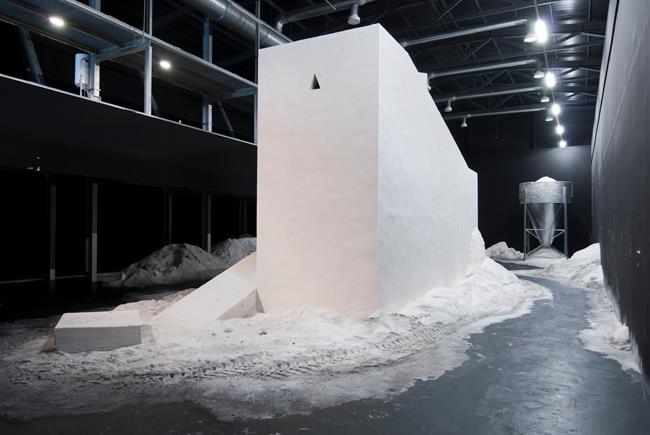 |
| Jorge Peris, Aladas Almas, 2011, image: La Conservera |
In Jorge Peris’s earliest childhood memory, which until recently he believed to be a dream, lies the uncanny presence of salt. For his latest exhibition, ”Aladas Almas” (Winged Souls), he traveled to the salt flats of San Pedro del Pinatar, Spain, to experience being surrounded by salt. This journey assisted him in creating the show’s mood, which consists of 170 tons of salt sculpted into an architectural structure resembling an ancient tower and mythological ruin. Salt also surrounds the structure, which contrasts with the gallery’s black walls. Installed nearby one finds a silo, an accelerated saline ecosystem, and a video, Oriens, 2011, featuring the Bolivian desert landscape of Uyuni seen through the artist’s eyes during his journey. The exhibition is not immediately visible from the building’s entrance; one accesses the work by walking around a high wall to view the contrast of salt against the dark space, an experience that invites profound feelings of independence and discovery, in part due to the installation’s magnitude.
Peris often uses salt to preserve his projects that employ organic materials; in addition, he spread the substance in a circle around his body to protect against insects as he was conducting research for the current exhibition. By watching these insects, he became fascinated with organisms that live in the harsh conditions of saline environments. The ecosystem he has created here supports an algae culture, which feeds a brine shrimp colony. As part of the process, their eggs are sprayed onto the white tower; the sculptural material will be returned to San Pedro del Pinatar at the show’s end, allowing eggs to hatch in their natural habitat. Once a material used to exclude living creatures from a zone, salt here becomes a way to promote marginalized entities. The ecosystem serves as a metaphor for life: Beauty—and even meaning—can be found in supporting forces at odds with the world. ”Winged Souls” is empowering, persuading us to take a second look at any given situation.
To see the review in context, click here.








